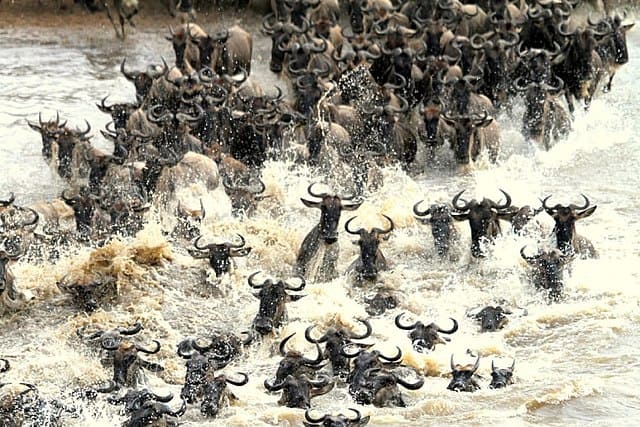Would you like to see one of the most fascinating natural phenomena of our time? Then follow the wildebeest migration in the Serengeti with this complete guide.
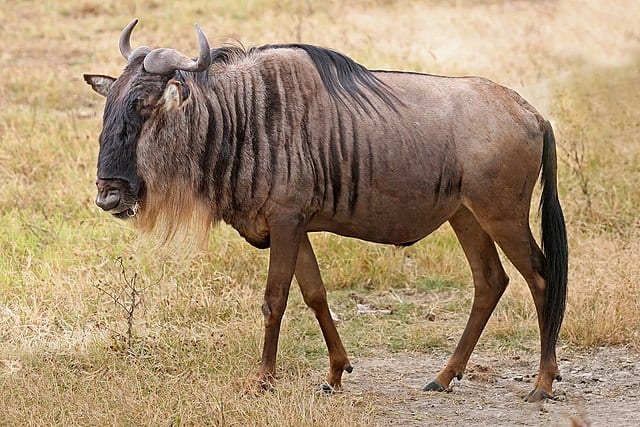
An African legend says that God assembled the wildebeest from leftover parts – harsh. But I think that their slightly odd look just makes them endearing.
Of course, they are not the most beautiful of all animals of the Serengeti but imagine wildebeests as far as the eye can see in the Savannah landscape. That’s pretty cool. Apart from Wildebeests, we are certain that you are interested in knowing more about the Big 5 in Africa. We gathered the Best places to see the Big 5 or All About Africa for you!
Key Points:
| Topic | Facts |
|---|---|
| Wildebeest Migration | Annual migration of wildebeests, zebras, and gazelles |
| Wildebeest Migration Facts | Over 1 million wildebeests, 2 million animals total |
| Migration Route | Varies each year, approximately 3,000 kilometers |
| Migration Calendar | December to November: Journey through different locations |
| Wildebeest Characteristics | Shoulder height: 4-5 feet, Length: 8-11.5 feet, Weight: 330-550 pounds |
| Climate Change Impact | Changing seasons affect migration cycle and route |
| Dangers during Migration | Hunger, thirst, predation, challenging river crossings |
| Booking Safari | Various operators offer wildebeest migration safaris |
| Best Time to Visit | June to September for the most spectacular parts of the migration |
The fact that the wildebeest of the Serengeti are still circling in millions today like they have done for ages, is a phenomenon.
In this article, you learn about the famous Wildebeest Migration. You can read the whole article from the beginning or jump straight to the most relevant chapter for you:
What is the Serengeti Wildebeest Migration?
Their migration is one of the largest ungulates on earth. And they are not alone, around 400,000 antelopes and 200,000 zebras join them. A journey of around 3,000 kilometers.
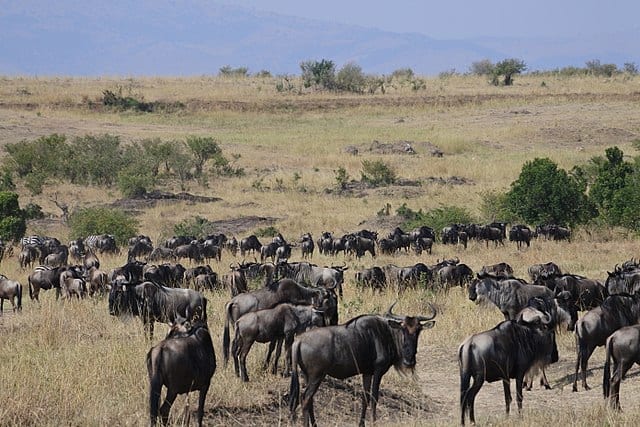
Wildebeests eat almost exclusively grass, and when a grazing ground is eaten, they move on. They follow an eternal cycle.
Quick Facts on Great Wildebeest Migration
- In total, more than two million animals move when the wildebeest migrate in the Serengeti – more than one million wildebeests and hundreds of thousands of zebras and Thomson’s gazelle.
- In January / February more than 500,000 wildebeests are born, about 8,000 per day.
- Each animal travels a thousand kilometers during migration.
- During the migration, wildebeests and zebras rely on each other. Wildebeests are like the water experts, great at sniffing out water sources, while zebras are the ones who’ve got the whole migration route down pat. They make a pretty great team!
- Every year, almost 250,000 wildebeests and 30,000 zebras die during the strenuous and dangerous migration.
Getting to Know the Wildebeest of the Masai Mara
| Trait | Description |
|---|---|
| Shoulder height | 4 – 5 feet |
| Length | 8 – 11,5 feet |
| Weight | 330 – 550 pounds |
| Diet | Herbivorous, primarily grasses |
| Conservation Status | Least Concern (IUCN) |
| Habitat | Grasslands, savannas, open woodlands |
| Geographic Range | Eastern and Southern Africa |
| Population Size | Approximately 1.5 million individuals |
When is the Wildebeest Migration?
Around February and sometimes into March, the wildebeests take a breather and welcome their newborn calves in the lush, grassy plains up in Tanzania’s Serengeti National Park. It’s like a baby boom during this calving period—over half a million little ones arrive in just a few weeks!
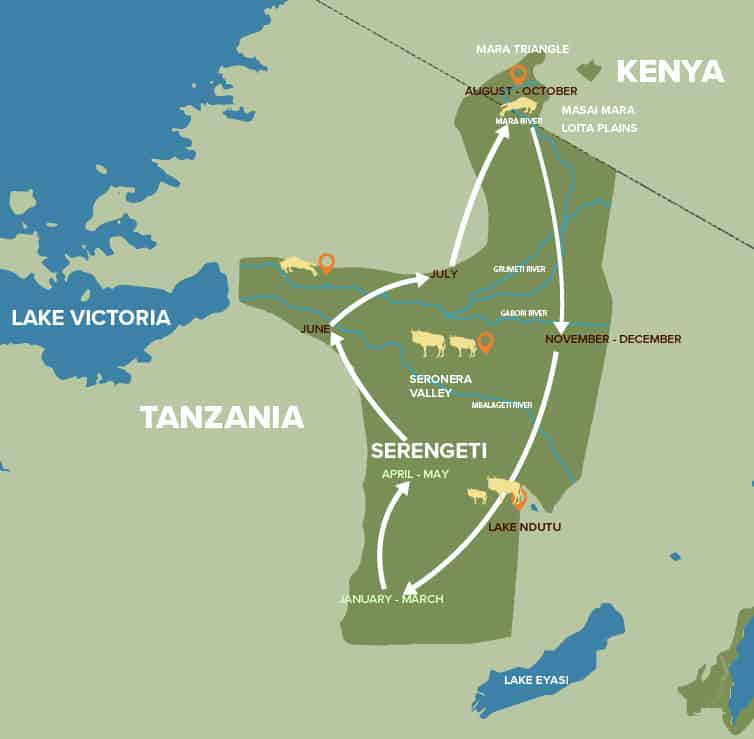
Around April, these animals start chasing the rain, making their way to the far west of Serengeti National Park. Then, step by step, they begin their journey northward through the heart of the Serengeti, aiming for the luscious grasslands in the Masai Mara down in southern Kenya.
By the end of the year, the migration swings back to the highlands of Tanzania, right at the start of the rainy season. It’s like a cycle—off to the south in search of rain-fed pastures and then back up north when the rainy season kicks off again.
Every wildebeest migration is different
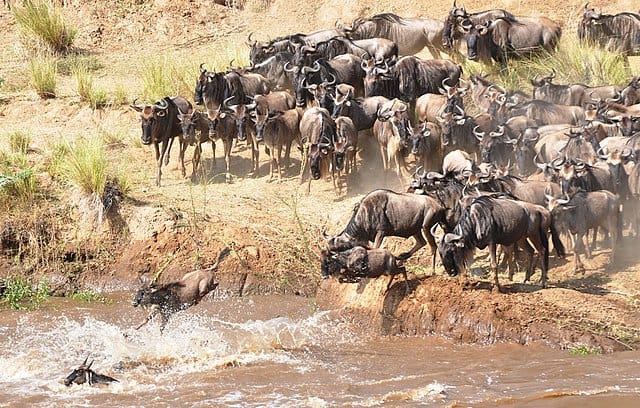
Each wildebeest migration is unique—the animals take a different route every year, so it’s pretty tough to predict where they’ll be headed. The Serengeti is massive, which means these herds can be tricky to track down at times.
Catching sight of the Great Migration is sort of a luck-of-the-draw situation. Having a top-notch safari guide also boosts your chances of catching the action.
Wildebeest Migration Monthly Calendar
| Month | Location | Description |
| December | Mara/ Loliondo, Tanzania | As the rains kick in, the migration gears up, and the herds bid farewell to the Mara, heading south to Loliondo. The grass there is fresh and lush, perfect for grazing. |
| January | Southern Plains, Tanzania | As they migrate to the short grasslands of the southern plains near Ngorongoro Crater, the wildlife population flourishes, and this is when zebras begin giving birth to their foals. |
| February | Serengeti Plains, Tanzania | On the plains, there are over 2 million zebras, wildebeests, gazelles, and elands roaming about. The predator activity picks up as this abundance of prey attracts them. It’s also the time when wildebeests start dropping their foals. |
| March | Serengeti Plains, Tanzania | The downpour begins, bringing in heavy rains. |
| April | Northern Plains, Tanzania | As the heavy rains intensify, the migration gradually begins its movement towards the western corridor. |
| May | Mbalageti River, Tanzania | The migration continues its journey, moving from the Mbalageti River area towards Grumeti. |
| June | Grumeti, Tanzania | As the dry season kicks off, crocodiles in the Grumeti Area begin preying on the wildebeests. |
| July | North East Grumeti, Tanzania | The migration shifts its route towards the Ikorongo or Lobo area, making its way northeast through the Grumeti region. |
| August | Ikorongo Area, Tanzania | As a new cycle kicks off with the arrival of rain, the migration heads back south. |
| September | Maasai Mara, Kenya | The migration persists, advancing towards the Mara in Kenya, driven by the quest for water and food. |
| October | Maasai Mara, Kenya | As the dry season concludes in the Serengeti, fresh water becomes available in the Maasai Mara. |
| November | Serengeti Plains, Tanzania | As a new cycle kicks off with the arrival of rains, the migration heads back south. |
Where can you experience the Wildebeest Migration?
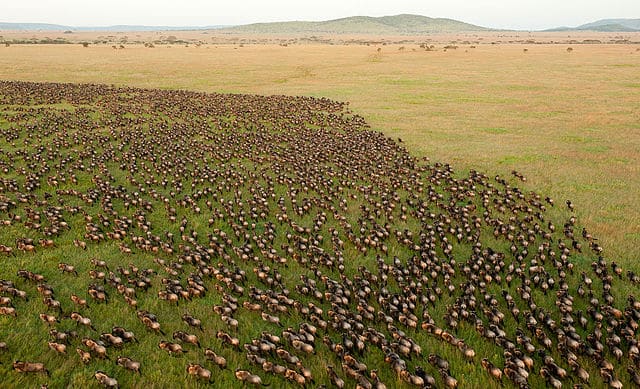
The Serengeti migration cyclically moves clockwise between the grazing lands of Tanzania’s Serengeti and Kenya’s Masai Mara Reserve, covering an impressive distance of nearly 3,000 kilometers.
Main Locations of the Wildebeest Migration
- Serengeti, Tanzania
- Maasai Mara, Kenya
The Serengeti and Masai Mara are part of a shared ecosystem. However, animals don’t recognize national borders and instinctively move toward areas with food and water.
They frequently migrate in groups of several thousand, following the migration path together. Yet, it’s common for some groups to stray from the usual route.
What is a Wildebeest (Gnu)?
When you think of antelopes, you usually see small, slender animals. Like the lightning-fast Thomson’s gazelle, for example. But also the big, strong wildebeests belong to the antelopes.
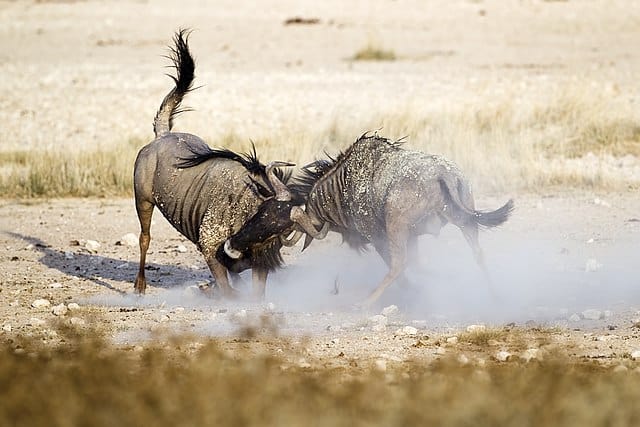
Wildebeests form large herds in which several thousand to one hundred thousand animals live. In the community, they have a greater chance of survival.
For example, if they want to cross a large river where crocodiles live. The more animals swim across together, the more difficult it becomes for the crocodiles to recognize a single animal and snap at it.
In many animals, there is a big difference between male and female animals. For example, the male is often larger and more colorful, but sometimes also the female. With the wildebeest it is different.
You can hardly see any difference, because both males and females are similar in size and carry both horns. But there is a trick to distinguish the animals: The forehead of the males is usually black, in females, it’s a rusty color.
But what makes them go on this long adventure? They follow the rain and the fresh grass. Studies show that wildebeest herds can locate precipitation from 50 kilometers away. Do they follow lightning or clouds? Do they hear the thunder? Do they smell the water?
Scientists have not yet found the answer. But not only the wildebeest but the entire ecosystem benefits from their migration: they produce 420 tons of dung per day. This fertilizer and the grazing of the grass allow the vegetation to grow faster.
Impact of Climate Change on Wildebeest and their migration
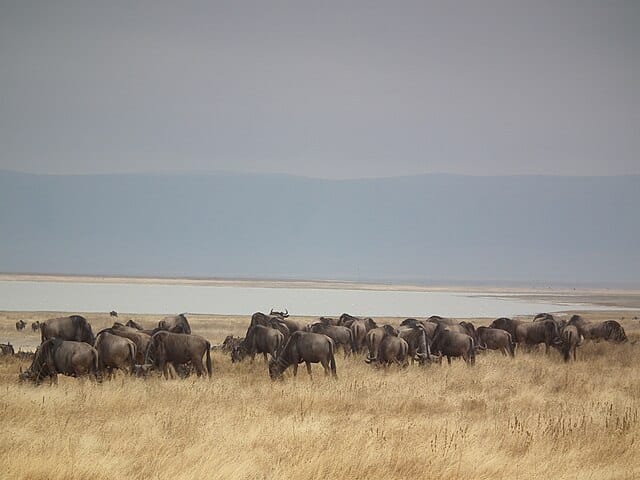
The wildebeest migration showcases how animals coexist and rely on one another: wildebeests excel at locating water, while zebras navigate the route, and both munch on different parts of the same grass.
This migration is heavily impacted by the fluctuating rainy and dry seasons. Sometimes, the climate shifts the cycle by several weeks, affecting the migration’s timing. Additionally, the route slightly alters each year.
A Journey with Many Dangers
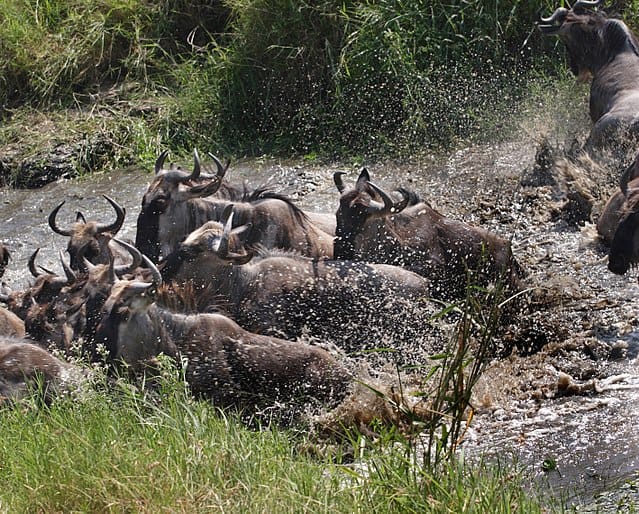
The great migration is a continuous process that returns every year. However, not without danger!
Each year, a considerable number of wildebeests and zebras perish during the arduous and perilous migration due to hunger, thirst, fatigue, or attacks from predators like lions, cheetahs, or hyenas, who are on the trail of the herd. Wildebeest calves are the most vulnerable.
A crucial point is the river crossing over the Mara River in the east of the Serengeti. The bank is steep, and the current is strong. There are also crocodiles lurking in the water, the biggest in the world. Not seldom panic breaks out among the animals. The Mara River crossing is one of the most dangerous parts of the Serengeti migration.
Humans are also a danger. On one side by poaching. On the other side by cutting down the forests and through farmers use the land for agriculture and irrigate it artificially.
The rivers carry less and less water. The wildebeest grazing grounds are becoming drier and cattle are grazing them.
Best Places to Book your Wildebeest Migration Safari
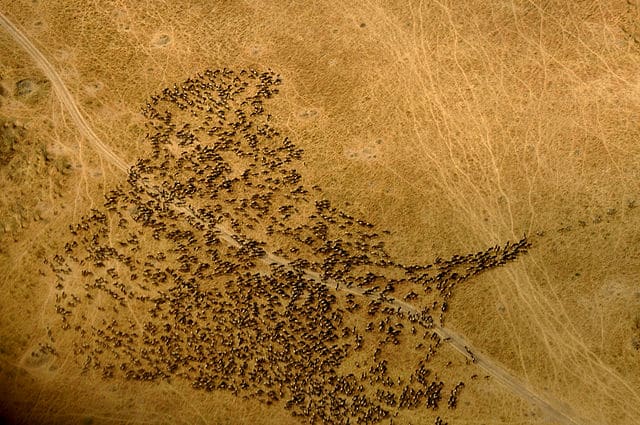
Multiple operators are offering amazing Wildebeest Migration Safaris.
Here are the most reliable ones (Rated on Google Maps and Trip Advisor):
Kenya Safaris
Tanzania Safaris
Best Time to Visit the Serengeti
To catch the breathtaking moments of the Wildebeest migration, your best bet is to head to the northern Serengeti or Masai Mara between June and September.
For the northern Serengeti, the travel days are quite lengthy. Staying a few days at one of the mobile camps is recommended, as this boosts your chances of witnessing the crossings.
| January Best travel time optimal safari conditions, births of the wildebeest babies | February Best travel time optimal safari conditions, herds in the south | September Best travel time landscape is very dry, ideal for safaris | April rainy season difficult for safaris, some lodges closed | May rainy season difficult for safaris, some lodges closed | June Best travel time ideal for Great Migration in the Western Corridor |
| July Best travel time Herds moving north towards Kenya | August Best travel time Herds reach the border of the Masai Mara | December Little rainy season nevertheless mostly ideal conditions | October Good travel time dust-dry, animals at the few water points | November Little rainy season Safaris still possible, minor restrictions | November Little rainy season Safaris are still possible, minor restrictions |
To witness the wildebeest’s annual baby boom in the Serengeti National Park, January and February are the prime months for traveling to the southern region of the park.
Best Time to Visit Maasai Mara
The weather in the Masai Mara Reserve is shaped by its location in the Kenyan highlands and the regular shift between rainy and dry seasons. Although you’ll have an amazing time whenever you go, I can highly recommend going when it’s not rainy season as this might restrict your activities (and who likes getting wet?)
| January Best travel time Optimal climate in Masai Mara | February Best travel time Optimal climate in Masai Mara | March Start of the rainy season as early as mid-March | April Great rainy season Safaris are nevertheless mostly possible | May Great rainy season Safaris are nevertheless mostly possible | June Start of dry season close vegetation |
| July Best travel time mostly beginning of the great migration of herds | August Best travel time mostly ideal for Great Migration | September Best travel time mostly ideal for Great Migration | October Best travel time End of the dry season | November Little rainy season Safaris are nevertheless mostly possible | December Little rainy season Safaris are nevertheless mostly possible |
In the dry season, there’s still a chance of rain, just not as often as during the rainy season. The main rainy stretch in Kenya typically begins from late March to late May, and the second rainy period usually falls between early November and mid-December, though these times can vary. During Kenya’s rainy season, expect brief but powerful showers that bring a lot of life to safaris. Even then, safaris are usually doable.
Follow the Wildebeest Migration
Thousands of tourists visit the migration every year. No wonder, the view is unique. Animals up to the horizon.
If you want to know in which region the wildebeest currently is, you can follow it on the website discoverafrica, which provides an App with photos, videos, and information about their wildlife observations.
The whereabouts of the herds are marked on Google Maps.
Do you enjoy reading about Wildlife?
You can read more about other migrations around the world in our article about animal migrations. Another spectacular natural event that we totally recommend and you might not have heard of is the Sardine Run. Go and check it out!
We also have more articles on the Wildebeest migration, wildlife in the Masai Mara National Reserve, and the top Safari parks in Africa to visit!
Join our Forum for free today!

- Third Elk Incident in Two Weeks in Estes Park, Colorado and How to Stay Safe - July 4, 2024
- 17 Animals That Mate For Life - June 24, 2024
- 13 Animals That Lay Eggs (Some Might Surprise You!) - June 16, 2024

